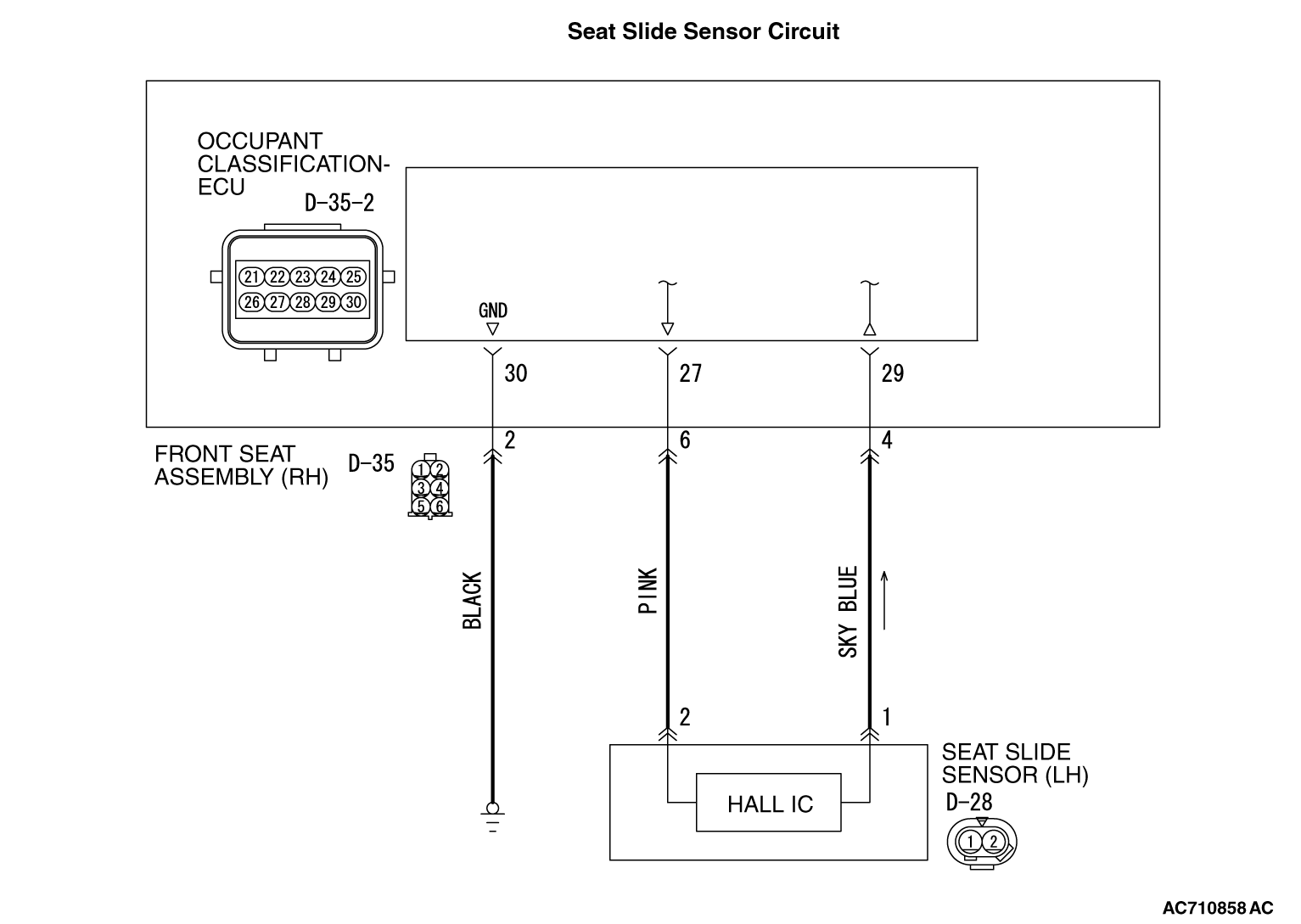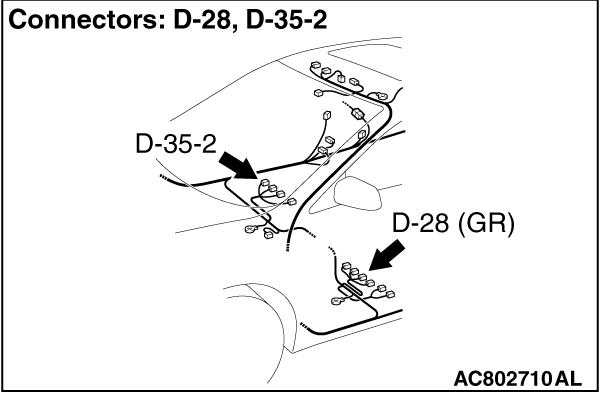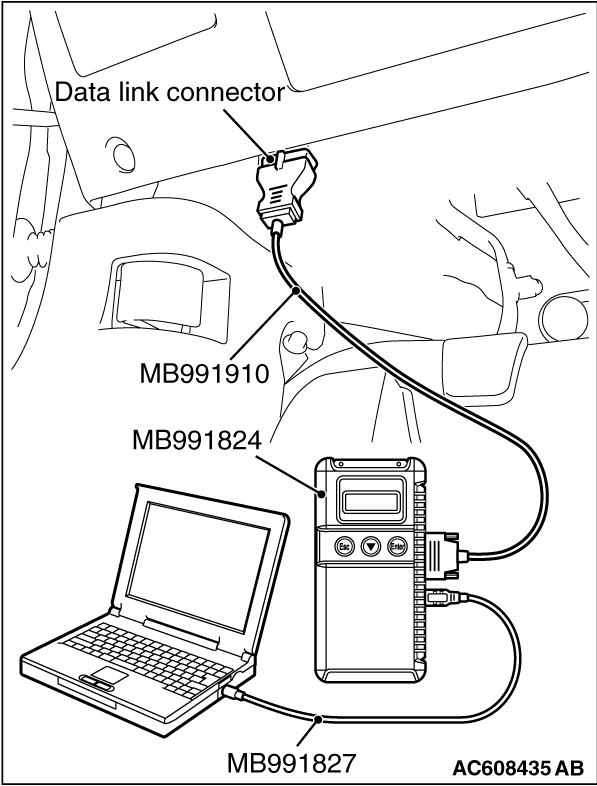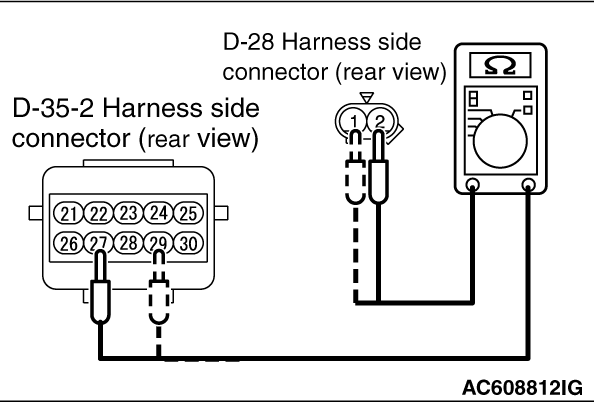![[Previous]](../../../buttons/fprev.png)
![[Next]](../../../buttons/fnext.png)
DTC B1B8D: Driver
Seat Slide Sensor Open Circuit


| caution |
If DTC B1B8D is set in the occupant classification-ECU, always
diagnose the CAN main bus lines.
|
CIRCUIT OPERATION
- The seat slide sensor sets the current value Hi or Low determined by the
seat position.
- The occupant classification-ECU determines the seat position according to the current
value from the seat slide sensor.
DTC SET CONDITIONS
- This DTC is set if there is abnormal resistance between
the input terminals of the seat slide sensor. The most likely causes for this code to be set
are the followings:
- Open circuit in the seat slide sensor or harness
TROUBLESHOOTING HINTS
- Open circuit in the seat slide sensor circuit
- Disengaged seat slide sensor connector
- Improper connector contact
- Malfunction of the seat slide sensor
- Malfunction of the occupant classification-ECU
|
|
Required Special Tools:
- MB991958: Scan Tool (M.U.T.-III Sub Assembly)
- MB991824: Vehicle Communication Interface (V.C.I.)
- MB991827: M.U.T.-III USB Cable
- MB991910: M.U.T.-III Main Harness A (Vehicles with CAN communication system)
|
|
|
STEP 1. Using scan tool MB991958, diagnose the CAN bus line.
|
|
|
| caution |
To prevent damage to scan tool MB991958, always turn the ignition
switch to the "LOCK" (OFF) position before connecting or disconnecting scan tool MB991958.
|
|

|
(1)Connect scan tool MB991958. Refer to "How to connect the scan tool  ." ."
(2)Turn the ignition switch to the "ON" position.
(3)Diagnose the CAN bus line.
(4)Turn the ignition switch to the "LOCK" (OFF) position.
Q.
Is the CAN bus line found to be normal?
 Go to Step 2. Go to Step 2.
 Repair the CAN bus line (Refer to GROUP 54C, Diagnosis Repair the CAN bus line (Refer to GROUP 54C, Diagnosis  ). ).
|
|
|
STEP 2. Recheck for diagnostic trouble code.
|
|
|
Check again if the DTC is set.
|
|
|
(2)Turn the ignition switch to the "ON" position.
|
|
|
(3)Check if the DTC is set.
|
|
|
(4)Turn the ignition switch to the "LOCK" (OFF) position.
|
|
|
 Go to Step 3. Go to Step 3.
|
|
|
|
|
|
 There is an intermittent malfunction such as poor engaged connector(s) or open
circuit (Refer to GROUP 00, How to Cope with Intermittent Malfunction There is an intermittent malfunction such as poor engaged connector(s) or open
circuit (Refer to GROUP 00, How to Cope with Intermittent Malfunction  ). ).
|
|
|
|
|
|
STEP 3. Check the harness for open circuit between occupant classification-ECU
connector D-35-2 (terminal No.27 and 29) and the seat slide sensor connector D-28 (terminal
No.2 and 1).
|
|
|
(1)Disconnect occupant classification-ECU connector D-35-2 and seat slide sensor connector
D-28.
|

|
(2)
| caution |
Do not insert a test probe into the terminal from
its front side directly, as the connector contact pressure may be weakened.
|
Check for continuity between the following terminals. It should be less than 2 ohms.
- Occupant classification-ECU connector D-35-2 (terminal No.27) and the seat
slide sensor connector D-28 (terminal No.2)
- Occupant classification-ECU connector D-35-2 (terminal No.29) and the seat slide
sensor connector D-28 (terminal No.1)
Q.
Does continuity exist?
 Go to Step 4. Go to Step 4.
 Repair the harness wires between occupant classification-ECU connector D-35-2
and seat slide sensor connector D-28. Repair the harness wires between occupant classification-ECU connector D-35-2
and seat slide sensor connector D-28.
|
|
|
STEP 4. Recheck for diagnostic trouble code.
|
|
|
Check again if the DTC is set to the occupant classification-ECU.
|
|
|
(2)Turn the ignition switch from "LOCK" (OFF) position to "ON" position.
|
|
|
(4)Turn the ignition switch to the "LOCK" (OFF) position.
|
|
|
 Replace the front seat cushion frame (LH) (Refer to GROUP 52A, Front seat assembly Replace the front seat cushion frame (LH) (Refer to GROUP 52A, Front seat assembly  ) <Except RALLIART>
or replace the slide adjuster (LH) (Refer to GROUP 52A, Front Seat Assembly ) <Except RALLIART>
or replace the slide adjuster (LH) (Refer to GROUP 52A, Front Seat Assembly  ) <RALLIART>.
Then go to Step 5. ) <RALLIART>.
Then go to Step 5.
|
|
|
|
|
|
 There is an intermittent malfunction such as poor engaged connector(s) or open
circuit (Refer to GROUP 00, How to Cope with Intermittent Malfunction There is an intermittent malfunction such as poor engaged connector(s) or open
circuit (Refer to GROUP 00, How to Cope with Intermittent Malfunction  ). ).
|
|
|
|
|
|
STEP 5. Recheck for diagnostic trouble code.
|
|
|
Check again if the DTC is set to the occupant classification-ECU.
|
|
|
(2)Turn the ignition switch from "LOCK" (OFF) position to "ON" position.
|
|
|
(4)Turn the ignition switch to the "LOCK" (OFF) position.
|
|
|
 Replace the front seat cushion frame (RH) (Refer to GROUP 52A, Front seat assembly Replace the front seat cushion frame (RH) (Refer to GROUP 52A, Front seat assembly  ) <Except RALLIART>
or replace the slide adjuster (RH) (Refer to GROUP 52A, Front Seat Assembly ) <Except RALLIART>
or replace the slide adjuster (RH) (Refer to GROUP 52A, Front Seat Assembly  ) <RALLIART>. ) <RALLIART>.
|
|
|
|
|
|
 There is an intermittent malfunction such as poor engaged connector(s) or open
circuit (Refer to GROUP 00, How to Cope with Intermittent Malfunction There is an intermittent malfunction such as poor engaged connector(s) or open
circuit (Refer to GROUP 00, How to Cope with Intermittent Malfunction  ). ).
|
|
|
|

 ."
." Go to Step 2.
Go to Step 2. Repair the CAN bus line (Refer to GROUP 54C, Diagnosis
Repair the CAN bus line (Refer to GROUP 54C, Diagnosis  ).
).![[Previous]](../../../buttons/fprev.png)
![[Next]](../../../buttons/fnext.png)


